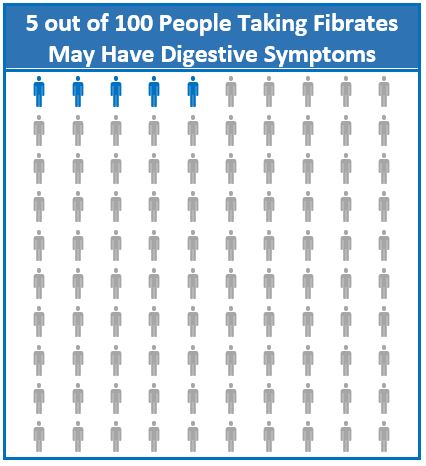Fibrates are a class of medication recommended to treat elevated triglycerides (TG) and low levels of high-density lipoprotein cholesterol (HDL-C) in order to lower the risk of cardiovascular events, like heart attack and stroke.1,2 Fibrates approved for use in the US include gemfibrozil and fenofibrate.3–5
The package insert for gemfibrozil reports the adverse event rates for 2,046 patients from the Helsinki Heart Study6 receiving the medication for up to five years compared to 2,035 taking placebo.3 A statistically significant higher rate of the following side effects occurred in patients taking gemfibrozil: dyspepsia (19.6% vs 11.9%), abdominal pain (9.8% vs 5.6%), acute appendicitis (1.2% vs 0.6%), and atrial fibrillation (0.7% vs 0.1%).
Adverse reactions that were reported in 2% or more of patients taking fenofibrate and in excess of those taking placebo are included in the table below.4,5 Statistical significance was not reported.

Patients taking gemfibrozil trended toward a greater prevalence of gallstones (7.5%) compared to those taking placebo (4.9%), but the statistical significance of this difference was not reported.3 In addition, an increase in the rate of gallbladder surgery among patients on gemfibrozil was also observed (1.9% vs 0.3%, p=0.07).
As with gemfibrozil, fenofibrate has been associated with an increased risk of gallstones.4,5 In addition, an increased risk of acute pancreatitis was observed in the Fenofibrate Intervention and Event Lowering in Diabetes (FIELD) study (n=9,795) (0.8 vs. 0.5%; p=0.031).7 The prescribing information warns against the use of fenofibrate in patients with gallbladder disease.
Abnormal liver function tests were observed more often in patients taking gemfibrozil which were reversed when gemfibrozil was discontinued. An estimated 20% of people taking gemfibrozil see mild transient elevations of serum transaminases, but values in excess of three times the upper limit of normal are seen in 5% or fewer.8 Elevation of liver function tests is also a common side effect of fenofibrate.4,5 Prescribing information for both fibrates recommends liver function tests before initiating fibrate therapy and a recheck after eight to 12 weeks. Treatment may be continued in patients with serum aminotransferase levels three times or less the upper limit of normal.1,3–5
Hypersensitivity reactions have also been reported in patients taking fibrates, but this is not common. Urticaria was reported in 1.1% and rash in 1.4% of patients taking fenofibrate compared to placebo (0% and 0.8%, respectively).4,5
The risk of myopathy is increased in patients taking fibrates, particularly when given in combination with statins.1,9 In the Fenofibrate Intervention and Event Lowering in Diabetes study, elevations of creatinine kinase (five times the upper limit of normal) were reported more frequently for patients on fenofibrate than on placebo, but the incidence of this abnormality was <1% in both treatment groups.8 In the same study (n=9,795), one case of rhabdomyolysis was reported in the placebo group and three cases in the fenofibrate group.
Fibrates are also associated with a significant rise in homocysteine levels.9 In one small study, homocysteine levels increased by 35.8% in patients taking fibrates (n=29) compared to patients taking atorvastatin (n=24) (p<0.0001).10 Elevated homocysteine is thought to be a weak marker for cardiovascular risk.9 These biochemical changes can be prevented with the concomitant use of folate supplementation, but the data supporting the use of folate to reduce cardiovascular disease events is lacking.9,11,12
Fibrates have been shown to cause mildly increased levels of creatinine but has not been shown to increase the risk of kidney dysfunction in clinical trials.13,14 The use of fibrates in patients with mild kidney disease is generally considered safe and reduces cardiovascular events but these drugs should be avoided in patients with severe kidney disease.14
References
- Catapano A, Graham I, DeBacker G et al. 2016 ESC / EAS guidelines for the management of dyslipidaemias. Eur Hear J 2016; 37 (39): 2999-3058.
- Grundy S, Stone N, Beam C, Birtcher KK, Harm PD. 2018 AHA/ACC/AACVPR/AAPA/ ABC/ACPM/ADA/AGS/APhA/ASPC/NLA/PCNA guideline on the management of blood cholesterol. J Am Coll Cardiol 2019; 73 (24): e285-e350.
- Lopid (gemfribrozil) [package insert]. New York, NY: Parke-Davis; 2008.
- Triglide (fenofibrate) [package insert]. Florham Park NJ: Shionogi Inc; 2012.
- Fenoglide (fenofibrate) [package insert]. San Diego, CA: Santarus, Inc; 2012.
- Frick MH, Elo O, Haapa K, et al. Helsinki Heart Study: primary-prevention trial with gemfibrozil in middle-aged men with dyslipidemia. Safety of treatment, changes in risk factors, and incidence of coronary heart disease. N Engl J Med 1987; 317 (20): 1237-1245.
- Keech A, Simes RJ, Barter P, et al. Effects of long-term fenofibrate therapy on cardiovascular events in 9795 people with type 2 diabetes mellitus (the FIELD study): randomised controlled trial. Lancet 2005; 366 (9500): 1849-1861.
- LiverTox -Clinical and Research Information on Drug-Induced Liver Injury - Gemfibrozil.
- Okopień B, Bułdak Ł, Bołdys A. Expert review of clinical pharmacology benefits and risks of the treatment with fibrates –– a comprehensive summary. Expert Rev Clin Pharmacol 2018; 11 (11): 1099-1112.
- Giral P, Bruckert E, Jacob N, Chapman MJ, Foglietti MJ, Turpin G. Homocysteine and lipid lowering agents. A comparison between atorvastatin and fenofibrate in patients with mixed hyperlipidemia. Atherosclerosis 2001; 154 (2): 421-427.
- Mayer OJ, Simon J, Holubec L, Pikner R, Subrt I. Fenofibrate-induced hyperhomocysteinemia may be prevented by folate co-administration. Eur J Clin Pharmacol 2003; 59 (5-6): 367-371.
- Clarke R, Halsey J, Lewington S, et al. Effects of lowering homocysteine levels with B vitamins on cardiovascular disease, cancer, and cause-specific mortality: Meta-analysis of 8 randomized trials involving 37 485 individuals. Arch Intern Med 2010; 170 (18): 1622-1631.
- Davidson MH, Armani A, McKenney JM, Jacobson TA. Safety considerations with fibrate therapy. Am J Cardiol 2007; 99 (6A): 3C-18C.
- Jun M, Zhu B, Tonelli M, et al. Effects of fibrates in kidney disease: a systematic review and meta-analysis. J Am Coll Cardiol 2012; 60 (20): 2061-2071.


